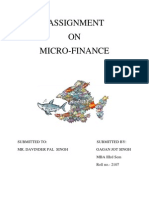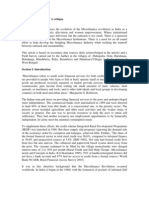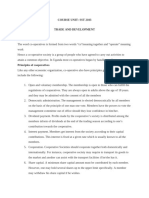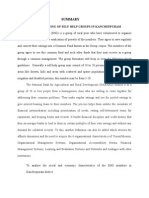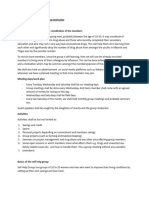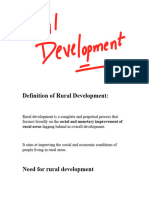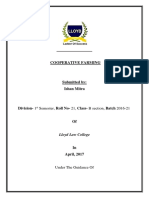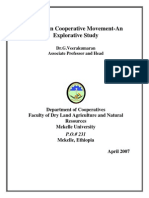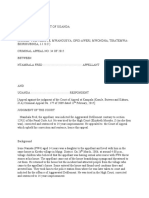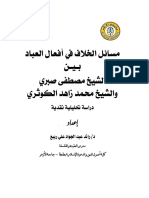Self-Reliance Is The Goal of Farmer Group 5 in Guédé Chantier, Senegal
Self-Reliance Is The Goal of Farmer Group 5 in Guédé Chantier, Senegal
Uploaded by
Fitri MelindaCopyright:
Available Formats
Self-Reliance Is The Goal of Farmer Group 5 in Guédé Chantier, Senegal
Self-Reliance Is The Goal of Farmer Group 5 in Guédé Chantier, Senegal
Uploaded by
Fitri MelindaOriginal Description:
Original Title
Copyright
Available Formats
Share this document
Did you find this document useful?
Is this content inappropriate?
Copyright:
Available Formats
Self-Reliance Is The Goal of Farmer Group 5 in Guédé Chantier, Senegal
Self-Reliance Is The Goal of Farmer Group 5 in Guédé Chantier, Senegal
Uploaded by
Fitri MelindaCopyright:
Available Formats
In a conversation Harwood had with the Deputy
Mayor of Gud Chantier, Senegal, Amadou Sy, the
Deputy Mayor talked about a recent meeting he had
with the presidents of the various farmers groups. In
that meeting he learned that Farmer Group 5 had CFA
11.5 million (approximately US$ 24,000) in a savings
account while the other groups had nothing approaching that amount.
A couple of days later, Harwood had the opportunity to sit down and talk with Abu Samba Sow, the
President of Farmer Group 5. He explained that the
current farmer groups were established in 1993 when
the dike was constructed around the community, covering up some fields thus necessitating a reassignment of
fields to members of the community. The community
was divided into 2 sections with each deciding on their
own organizational pattern.
Section 1 established 5 groups and Group 5 elected
Sow as President. As he says, In my vision, I structured the organization of the group into three levels:
the General Assembly, the Executive Board, and the
Advisory Board. The most important group is the
General Assembly. I was the President from 1993 to
2002 and then wanted to retire. So I called a meeting
of the General Assembly and told them I wanted to
rest. That created a big stir in Group 5 and the General
Assembly said, No, you cannot resign! What we will
do is elect you as President and you choose the bureau
members. I tried to say no, no, no, but finally what
you cannot resist, you must accept.
As for the management of my group, I really had
to do it, though it was beyond my strength. To help
me, I appointed bureau members and these appointments were validated by the General Assembly. The
General Assembly asked the people holding office to
exercise a strict discipline. The Executive Board and
the 5 sub-groups I established, each led by a chief, had
a precise set of tasks they were to achieve.
The other farmer groups in Gud Chantier are
dependent upon the bank, but this is not true for Group
5. After a couple of years, group 5 decided that they
couldnt go without a savings account so they started
one. The group expects each hectare to contribute to
the financial security of the group. To accomplish their
goal of financial security the group decided on their
own set of rules.
There are two categories of fines. Someone who
does not work or misbehaves is fined for misbehavior. If the rules are broken, the leader determines the
amount of the damage according to the seriousness
from CFA 5,000 to CFA 50,000. These fines are put
into the savings account. The group has community
fields of 15 Ha and the profit from these are also put
into the savings account. Part of our rules are that each
campaign must pay its own debt. If you grow rice, you
pay from that campaign not tomatoes.
Every time we harvest, when the last person
finishes their harvest, the deadline for payment is the
next Monday. People are required to pay their debt with
either cash or the crop immediately following harvest.
Those who do not pay on time are fined. The sanction
is different if they use the crop to feed their family or
if they use it to invest in another plot of land outside
the group, they are charged a percentage of the debt.
During the cool season (January April), farmers in
Gud Chantier, Senegal plant tomatoes, maize, cabbage, onions, and okra. The field in the foreground
is tomatoes. The fields in the center and back of the
picture contain maize inter-planted with various vegetable crops. Many of the trees in the background are
mango trees which were in bloom during Harwoods
February visit. They will bear fruit later in the year.
Then everything we get from sanctions and fines
goes into the account when we finish. We then harvest
the weeds and sell them to the herders. This also goes
into the savings account.
Then we have boxes to carry tomatoes for weighing and the charges for the boxes are put into the account. All we have in common goes into the savings
account.
At the end of the harvest, we evaluate everything
that did not work from a technical or financial perspective.
Last Saturday (February 8, 2014) we had a General Assembly and I invited a director of the bank who
Cont. on p. 2
Article Number 715
Originally published in MidAmerica Farmer Grower, Vol. 35, No. 15, April 11, 2014
Reproduction Permission Granted with 1) full attribution to Daryll E. Ray and the Agricultural Policy Analysis Center, University of Tennessee, Knoxville, TN;
2) Copy of reproduction sent to Information Specialist, Agricultural Policy Analysis Center, 309 Morgan Hall, Knoxville, TN 37996-4519
PolicyPennings by Daryll E. Ray & Harwood D. Schaffer
Self-reliance is the goal of Farmer Group 5 in
Gud Chantier, Senegal
Self-reliance is the goal of Farmer Group 5 in Gud Chantier, Senegal
Cont. from p. 1
spent the day with us. During our last evaluation we
realized that we had CFA 11.5 million. For the new
crop we have a loan from the bank for approximately
CFA 25 million and CFA 8 million from the group
bank account. 28 percent of the cost of putting in the
new crop comes from the savings of the Group 5. The
interest we will pay back to the bank is CFA 1.5 million. We realized that if this interest rate was going
back into our savings account, we could soon fund our
own loans. Our objective is to fully fund our farming
activities.
The transparency of the leadership group is very
important. We have three campaigns a year: dry, rain,
cool. We meet at length three times a year as the General Assembly before sowing. The leadership visits
each field visit three times during each campaign. The
Executive Board calculates the dues for each person
in the group and that money is put into the savings
account. The General assembly meets at least 9 times a
year plus the annual meeting and the Executive Board
schedules a meeting whenever necessary.
One of the goals that the community leaders and
Harwood set for themselves is to find ways for the
other farmer groups to learn the self-management tools
that Group 5 has developed. In that way the farmers
can exercise greater control over their financial and
agricultural destiny. If the groups have adequate financial reserves, then they can finance crops other than
those the bank is willing to financerice, tomatoes,
and onionsand find additional ways to improve the
financial and nutritional stability of Gud Chantier.
Daryll E. Ray holds the Blasingame Chair of Excellence in Agricultural Policy, Institute of Agriculture,
University of Tennessee, and is the Director of UTs
Agricultural Policy Analysis Center (APAC). Harwood D. Schaffer is a Research Assistant Professor
at APAC. (865) 974-7407; Fax: (865) 974-7298;
dray@utk.edu and hdschaffer@utk.edu; http://www.
agpolicy.org.
You might also like
- TMSS - Asif-1Document42 pagesTMSS - Asif-1Asif Ahmed83% (6)
- Syllabus Fintech 2019Document5 pagesSyllabus Fintech 2019Bob matsinNo ratings yet
- Speakout Vocabulary Extra Upper Intermediate Unit 8Document3 pagesSpeakout Vocabulary Extra Upper Intermediate Unit 8Olga KohnoNo ratings yet
- SHG ProjectDocument26 pagesSHG ProjectShreyaaNo ratings yet
- Narrative Approach To Study Business Model of Flower Sellers and Role of Micro FinanceDocument34 pagesNarrative Approach To Study Business Model of Flower Sellers and Role of Micro FinanceKrishnamurthy PrabhakarNo ratings yet
- ScriptDocument7 pagesScriptAyush BhadauriaNo ratings yet
- Assignment ON Micro-FinanceDocument24 pagesAssignment ON Micro-FinancerakeshpataelNo ratings yet
- Microfinance in India: A Critique by Rajarshi GhoshDocument9 pagesMicrofinance in India: A Critique by Rajarshi Ghoshpraveen_jha_9No ratings yet
- Microfinace Reading PDFDocument9 pagesMicrofinace Reading PDFCharles GarrettNo ratings yet
- Pioneer Review, February 21, 2013Document14 pagesPioneer Review, February 21, 2013surfnewmediaNo ratings yet
- Women Saving Scheme (Self Help Group)Document17 pagesWomen Saving Scheme (Self Help Group)Revathi RamaswamiNo ratings yet
- MF Module 4Document23 pagesMF Module 4Rekha MadhuNo ratings yet
- Agricultural Economics Chapter 5 & 6Document85 pagesAgricultural Economics Chapter 5 & 6Genemo FitalaNo ratings yet
- Human Capital Formation-2. Development of Productive Resources - 3. Development of Rural Infrastructure - 4. Land Reforms - 5. Lessening PovertyDocument14 pagesHuman Capital Formation-2. Development of Productive Resources - 3. Development of Rural Infrastructure - 4. Land Reforms - 5. Lessening PovertyPoonamlimsNo ratings yet
- Self Help GroupDocument3 pagesSelf Help GroupMansiNo ratings yet
- Rushikesh Kale Abmp 201738 1Document75 pagesRushikesh Kale Abmp 201738 1Yogesh VeerNo ratings yet
- Unit 3 Micro Finanance Credit Lending ModelDocument7 pagesUnit 3 Micro Finanance Credit Lending Modeljcmxqxz7tcNo ratings yet
- Social Welfare Activities: Various Activities in Edaicode Town PanchayatDocument8 pagesSocial Welfare Activities: Various Activities in Edaicode Town PanchayatramNo ratings yet
- International Co-Op Move - Module IV - (B. COM)Document4 pagesInternational Co-Op Move - Module IV - (B. COM)gaganatk1257No ratings yet
- Rural DevelopmentDocument40 pagesRural DevelopmentrobockxxNo ratings yet
- HeybuddycheckDocument38 pagesHeybuddycheckManish kumarNo ratings yet
- Viability of Granting Credit To Small FarmersDocument50 pagesViability of Granting Credit To Small FarmersLalaine aguilarNo ratings yet
- Agricultural Credit FDocument7 pagesAgricultural Credit FRafiulNo ratings yet
- 2017 One Acre FundDocument14 pages2017 One Acre FundThanh Phu Tran0% (1)
- SHG & JLGDocument5 pagesSHG & JLGManasi PatilNo ratings yet
- Micro Finance SHG PPT 120928142952 Phpapp01Document30 pagesMicro Finance SHG PPT 120928142952 Phpapp01Aaryan Singh100% (2)
- 975 Project ProposalDocument6 pages975 Project Proposalanwesh pradhanNo ratings yet
- Aim High Development GroupDocument14 pagesAim High Development GroupMukiibi DuncanNo ratings yet
- Advantages of Cooperative FarmingDocument10 pagesAdvantages of Cooperative FarmingMoazzam W2100% (1)
- Mcom Final Internship BankDocument13 pagesMcom Final Internship BankRahul D LekshmanNo ratings yet
- TRADE AND DEVELOPMENTDocument12 pagesTRADE AND DEVELOPMENTrichardrokello93No ratings yet
- Unit 2 MFRBDocument31 pagesUnit 2 MFRBSweety TuladharNo ratings yet
- Agricultural CooperativesDocument6 pagesAgricultural CooperativesOMOTOSO AJEWOLENo ratings yet
- Anas Co OperativeDocument12 pagesAnas Co OperativeMaths TeacherNo ratings yet
- Impact Assessment of Micro FinanceDocument27 pagesImpact Assessment of Micro Financenisith12No ratings yet
- BAFT Cooperation I Module IDocument12 pagesBAFT Cooperation I Module IBeyond the Thoughts ANNo ratings yet
- Constitution / Governing DocumentDocument4 pagesConstitution / Governing DocumentAll Animal RightsNo ratings yet
- A Self Help GroupDocument2 pagesA Self Help GroupmlachuNo ratings yet
- Micro Finance SHG PPT 120928142952 Phpapp01Document30 pagesMicro Finance SHG PPT 120928142952 Phpapp01karanjangid17No ratings yet
- 04 Chapter 1Document30 pages04 Chapter 1eshachanga1234No ratings yet
- Work PlanDocument3 pagesWork Planmungaijoseph390No ratings yet
- Eco Notes-1Document39 pagesEco Notes-1aniketsawant8003No ratings yet
- Rural DevelopmentDocument27 pagesRural Developmentakp200522No ratings yet
- CH 3 Institutional Support To International BusinessDocument77 pagesCH 3 Institutional Support To International Businessgouthamireddy75No ratings yet
- Unit-12 Fund RaisingDocument23 pagesUnit-12 Fund RaisingNeha Jayaraman100% (1)
- Micro Finance LastDocument30 pagesMicro Finance Lastnishantbali100% (11)
- Ucsp Q2 M2Document2 pagesUcsp Q2 M2Carl Patrick LoronoNo ratings yet
- 1Document43 pages1ravneet0No ratings yet
- Fms Project-Microfinance in IndiaDocument25 pagesFms Project-Microfinance in Indiaashu181186No ratings yet
- CreditDocument3 pagesCreditLovely Mae GalosNo ratings yet
- Economics Chapter 6 Rural DevelopmentDocument9 pagesEconomics Chapter 6 Rural Developmentprasannakumart78No ratings yet
- Cooperative in IndiaDocument36 pagesCooperative in IndiakhadagNo ratings yet
- Indian Economic System AnswersDocument23 pagesIndian Economic System Answersguneet sandhuNo ratings yet
- Cooperative Farming: Semester, Roll No-21, Class - B Section, Batch 2016-21Document9 pagesCooperative Farming: Semester, Roll No-21, Class - B Section, Batch 2016-21Mitra IshanNo ratings yet
- Ethiopian Cooperative Movement by G.veerakumaranDocument114 pagesEthiopian Cooperative Movement by G.veerakumaranPuneet100% (2)
- Acknowledgement: Mrs. Rajam Rajagopalan For Her Exemplary Guidance, Monitoring and ConstantDocument41 pagesAcknowledgement: Mrs. Rajam Rajagopalan For Her Exemplary Guidance, Monitoring and ConstantVineeth MudaliyarNo ratings yet
- State Rural Initiatives: Where The Money Comes FromDocument16 pagesState Rural Initiatives: Where The Money Comes FromThe Council of State GovernmentsNo ratings yet
- Self-Help Group (SHG) of India: Meaning, Need and ObjectivesDocument4 pagesSelf-Help Group (SHG) of India: Meaning, Need and Objectivesvankamamidi4302No ratings yet
- 10-Money and Credit NotesDocument6 pages10-Money and Credit NotesNagulan MadhavanNo ratings yet
- Summary of Daryl Collins, Jonathan Morduch, Stuart Rutherford & Orlanda Ruthven's Portfolios of the PoorFrom EverandSummary of Daryl Collins, Jonathan Morduch, Stuart Rutherford & Orlanda Ruthven's Portfolios of the PoorNo ratings yet
- The Worker Center Handbook: A Practical Guide to Starting and Building the New Labor MovementFrom EverandThe Worker Center Handbook: A Practical Guide to Starting and Building the New Labor MovementNo ratings yet
- ENV107.Lab Report 2. Dr. Abdus Samad Azad (ASA2)Document9 pagesENV107.Lab Report 2. Dr. Abdus Samad Azad (ASA2)Jannatul TrishiNo ratings yet
- Supreme Court Uganda 2018 1Document11 pagesSupreme Court Uganda 2018 1Musiime Katumbire HillaryNo ratings yet
- Chang Tsung-Tung 1988 Indo-European Vocabulary in Old ChineseDocument60 pagesChang Tsung-Tung 1988 Indo-European Vocabulary in Old ChinesehuludusNo ratings yet
- AGH 111 Agricultural Heritage All LectureDocument82 pagesAGH 111 Agricultural Heritage All LectureBsc Study.inNo ratings yet
- Handmaid's EssayDocument2 pagesHandmaid's EssayZulfa Ali Yousuf AbdullahNo ratings yet
- USAF Leadership Manual by PUSHKALDocument131 pagesUSAF Leadership Manual by PUSHKALPushkal DwivediNo ratings yet
- Syeda Maryam TahirDocument1 pageSyeda Maryam Tahirzaidigitaltools1No ratings yet
- MCGPI 2020 Full ReportDocument91 pagesMCGPI 2020 Full ReportStratos PourzitakisNo ratings yet
- Xaver100 WebDocument2 pagesXaver100 WebMossad NewsNo ratings yet
- افعال العباد ورقةDocument100 pagesافعال العباد ورقةQuantum SaudiNo ratings yet
- Guidelines of HRD-TDF 2022Document10 pagesGuidelines of HRD-TDF 2022Esther SiliangNo ratings yet
- Indirect SpeechDocument3 pagesIndirect SpeechChava MtzNo ratings yet
- MeshDocument30 pagesMeshPooja PatelNo ratings yet
- Memorandum of AgreementDocument5 pagesMemorandum of AgreementJayson AbreraNo ratings yet
- Which Statement Is True in Regards With Recurring Entry ProgramDocument24 pagesWhich Statement Is True in Regards With Recurring Entry Programesiti nurrikaNo ratings yet
- Akta IPTS Pindaan 2021Document24 pagesAkta IPTS Pindaan 2021Junx LimNo ratings yet
- UN@70: Achievements, Failures and The Way ForwardDocument6 pagesUN@70: Achievements, Failures and The Way ForwardInstitute of Policy Studies100% (1)
- 1267/1989 Sanctions List Last Updated On: 2 October 2015Document58 pages1267/1989 Sanctions List Last Updated On: 2 October 2015Jose Gregorio Diaz UribeNo ratings yet
- Project Report On Cyber Security and Cyber Crime Involving Estonia Case, Homeland Security and Athens AffairDocument41 pagesProject Report On Cyber Security and Cyber Crime Involving Estonia Case, Homeland Security and Athens AffairSameer R. Khan40% (5)
- He Aily Nion: Junction CityDocument16 pagesHe Aily Nion: Junction CityDUNewsNo ratings yet
- BECC Accomplishments - November 19, 2014 ENGDocument62 pagesBECC Accomplishments - November 19, 2014 ENGManuel F. Rubio GallegoNo ratings yet
- LKPD Narrative 1 Kelas XDocument4 pagesLKPD Narrative 1 Kelas XRina DewiastutiNo ratings yet
- History ProjectDocument4 pagesHistory Projectshaw.linkedNo ratings yet
- Singer LTD SolutionDocument2 pagesSinger LTD SolutionWaseim khan Barik zaiNo ratings yet
- London - Vicky ShiptonDocument3 pagesLondon - Vicky ShiptonGabriela GuevaraNo ratings yet
- Java Project CopiedDocument18 pagesJava Project Copiedanimeshdorugade244No ratings yet
- First Semester Timetable UpdatedDocument3 pagesFirst Semester Timetable Updatedwahbless279No ratings yet
- Ayokunu Babalola OfferDocument8 pagesAyokunu Babalola OfferBabalola AyokunuNo ratings yet






